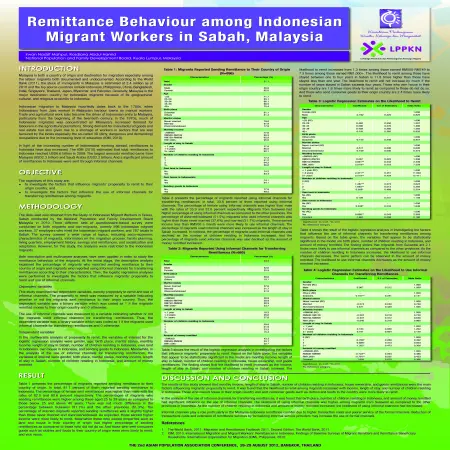Browse by Type
Results for Item type : "Scientific Poster"
|
|
The impact of Indonesian migrants from the locals' perception: a study in Sabah, Malaysia
Item Type: Scientific Poster
Editor:
Year: 00/08/2012
Abstract: Being a developed country, Malaysia has been receiving a large number of labour migrants from other neighboring countries. Statistics show that the total number of non-Malaysians in 2010 is 2.3 million compared to 1.3 million in the year 2000. It is over 8 percent of the total population in Malaysia and comprises mostly of Indonesian migrants. This phenomena has a great impact on Malaysia and its people. The objective of this study is to determine the impact of Indonesian migrants from the locals' perception and also to determine if gender, ethnicity, religion, marital status, educational level, job industry and monthly income make a difference in their perception. The data used for this study were obtained from the Study on Indonesian Migrants in Tawau, Sabah conducted by the National Population and Family Development Board (NPFDB) Malaysia in 2010. The survey managed to obtain information from 787 locals in Tawau. The dependent variable is the overall perception of the locals on the impact of the Indonesian migrants while the independent variables are gender, ethnicity, religion, marital status, educational level, job industry and monthly income. Independent t-test and analysis of variances (ANOVA) were applied to the data set. As a result, this study indicates that the locals in Tawau feel that the presence of the Indonesian migrants does have an effect on them. The mean score obtained was 95.053 out of a total of 135. The results of ANOVA showed that ethnicity (F = 6.950, df = 7), marital status (F = 12.320, df = 3), education level (F = 4.058, df = 7), job industry (F = 27.374, df = 3), and monthly income (F = 15.201, df = 6) contributed to the differences in the locals' perception on the impact of Indonesian migrants. Only gender and religion does not affect their perception. Thus, the entrance of Indonesian workers needs to be monitored as their presence are affecting the locals.
|
|
|
|
|
|
Remittance behaviour among Indonesian migrant workers in Sabah, Malaysia
Item Type: Scientific Poster
Editor:
Year: 00/08/2012
Abstract: Malaysia is both a country of origin and destination for migration especially among the labour migrants both documented and undocumented. According to The World Bank's Migration and Remittances Factbook 2011, the stock of immigrants in Malaysia is estimated at 2.4 million as at 2010 and the top source countries include Indonesia, Philippines, China, Bangladesh, India, Singapore, Thailand, Japan, Myanmar, and Pakistan. Generally, Malaysia is the major destination country for Indonesian migrants because of its geographical, cultural, and religous proximity to Indonesia.
The objective of this study is to investigate remittance behaviour among Indonesian migrants including the decision to remit and use of informal methods of transferring remittance. The data used was obtained from the Study of Indonesian Migrant Workers in Tawau, Sabah conducted by the National Population and Family Development Board Malaysia in 2010. Three different sets of questionnaire-based survey were conducted on both migrants and non-migrants, namely 896 Indonesian migrant workers, 37 employers who hired the Indonesian migrant workers, and 787 locals in Sabah. Both descriptive and multivariate analyses have been applied in order to study the remittance behaviour of the migrants. At the initial stage, the descriptive analysis explained the percentage of migrants who send remittance and migrants who use informal channels according to their characteristics. Then, logistic regression analysis was performed to investigate the factors that influence migrants' decision to send remittance and the use of informal methods of transferring remittance. The results of this study showed that age, monthly income, number of children residing in Indonesia, having own house in Indonesia and sending goods to Indonesia are the main factors contributing to the migrants' decision to remit. It was found that the likelihood to remit among migrants increased with age, income and number of children residing in Indonesia. Those who own house in their origin country and sending goods to the country are more likely to remit. In the analysis of methods of transferring remittance, it was found that birth place, number of children residing in Indonesia and the total amount of money remitted have significant relationship with the use of informal channels. The likelihood of using informal channels is higher among migrants from Sulawesi as compared to the other parts of Indonesia. As the number of children residing in Indonesia and amount of money remitted increased, the likelihood of using informal channels had decreased.
|
|
|
|






